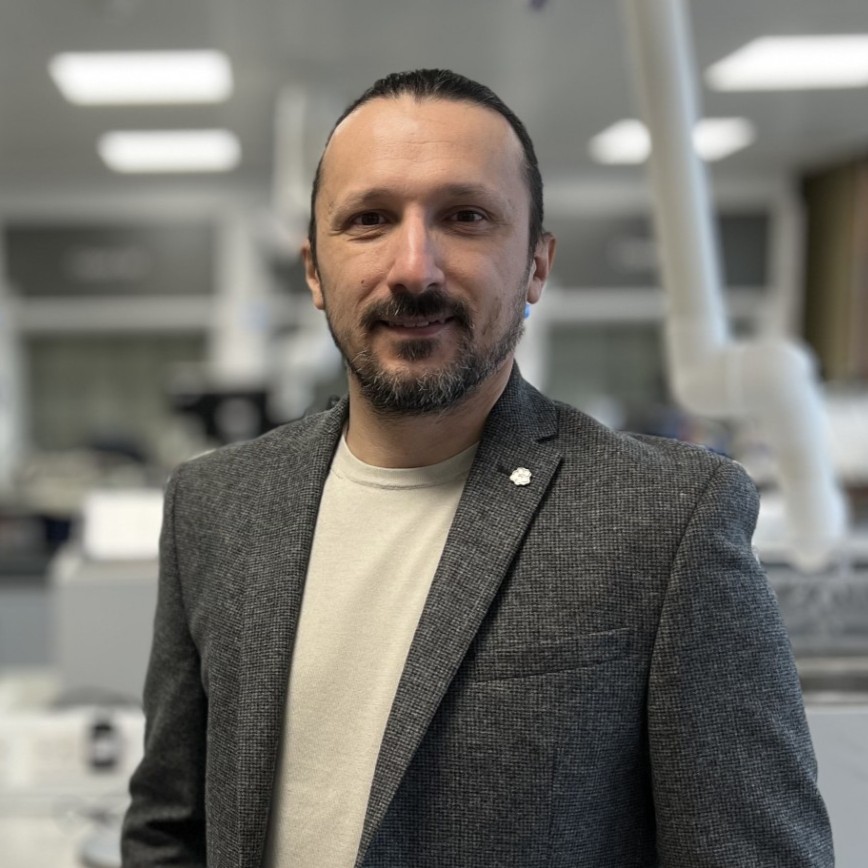My vision in research is to develop solutions to unique problems associated with human health via scientific breakthroughs in biochemical systems and material science. In my research group, we focus on the problems with bioelectrode development using various recognition elements, device design, and investigation of alternative materials. Possible solutions to such problems will improve prognosis, diagnosis, patient care, and provide cost-effective and environmentally friendly solutions.
Check out the Şahin Research Group website
The group has an interconnected structure that allows researchers from different backgrounds to work collaboratively on different topics. As an engineering research group, one of the primary objectives is to translate scientific results in basic research into products and devices to benefit humans, especially for healthcare. To do this, the developments in biosensor and materials research are applied in wearable and/or implantable devices.
I received research funding from several funding sources in different countries. These include research councils (Scientific and Technological Research Council of Türkiye, TÜBİTAK), institutions (Health Institutes of Türkiye, TÜSEB), and non-profit organisations (Breakthroguth T1D, USA, and Fulbright Commission TR-USA).
Module Convenor for
- ENGR265 Chemical Engineering Laboratory Projects I (2023 - )
and teach the following modules
- ENGR101 Fundamentals of Engineering Science (2024 - )
- ENGR302 Chemical Process Design Project (2023 - )
- ENGR495 MEng Dissertation Project (2024 - )
- ENGR 300/301 BEng&MEng Individual Projects (2024 - )
Before joining Lancaster, I taught several modules in Chemical Engineering, Bioengineering, Materials Engineering, Biotechnology, and Molecular Biology and Genetics programmes.
Committee Service for Learned and Professional Societies:
- Institution of Chemical Engineers (IChemE)
- Associate Member (AMIChemE)
- Committee Member of the North Lancashire Member Group
- Society of Chemical Industry (SCI)
- Member
- Committee Member of the Electrochemical Technology Group
- Royal Society of Chemistry (RSC)
- International Society of Electrochemistry
Panellist and External Reviewer Roles:
- UK Research and Innovation (UKRI)
- Breakthrough T1D, USA
- US-UK Fulbright Commission
- TÜBİTAK, Türkiye
- TÜSEB, Türkiye
Engagement Activities:
Prof Eileen Yu (PhD Supervisor)
Prof Michael Catt (Postdoctoral Advisor)
Prof John A Rogers (Postdoctoral Advisor)
Honours and Awards
(Professional)
- FHEA, Fellow of Advance HE (2025)
- Research Excellence Award, Bilecik SE University (2023)
- Research Excellence Award, Bilecik SE University (2022)
- Fulbright Post Doctoral Fellowship (2020)
- Republic of Türkiye Ministry of National Education PhD Scholarship
(2012 – 2017) - Winner of Engineering YES Elevator Pitch Prize, Team member (2013)
- Fulbright Opportunity Grant (2010)
(Sports)
- Co-founder of NeoDo Taekwondo Academy (2025)
- National Sports Fellowship of the Turkish Government, Türkiye (2005 – 2011)
- Turkish National Taekwondo Team, Member (2003)
- Turkish Taekwondo Champion
- Silver Medallist in the European Taekwondo Championship, Athens, Greece
- Silver Medallist in the International Taekwondo Championship, Trelleborg, Sweden
Supervision Interests
There are several undergraduate projects available in the group. All of them are suitable for Chemical Engineering or related subjects. Please contact me for more information or express your interest via our website.
Funded PhD and PDRA opportunities are advertised via the Lancaster University Job Vacancies website and other job advertisement websites (e.g. jobs.ac.uk).
Self-funded students and researchers are welcome and encouraged to contact me to discuss possibilities.
